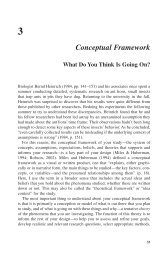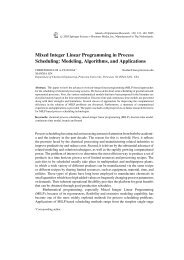Qualitative Research Basics: A Guide for Engineering Educators
Qualitative Research Basics: A Guide for Engineering Educators
Qualitative Research Basics: A Guide for Engineering Educators
Create successful ePaper yourself
Turn your PDF publications into a flip-book with our unique Google optimized e-Paper software.
• Gather the stories of the individual through multiple data sources.<br />
• Collect in<strong>for</strong>mation on the context within which these stories occur.<br />
• ”Restory” these experiences into a general framework that may link key elements,<br />
provide a chronological story, or explore larger themes.<br />
• Explore the meaning of these stories, with input from both the researcher and the<br />
subject.<br />
Although narrative analysis is focused on the experience of single individuals, when<br />
framed properly it can provide insights into larger issues that cut across multiple<br />
experiences. For example, Merriam (2002) reprints a narrative study in which a woman<br />
in a management position in a large corporation confronted and dealt with issues of<br />
sexism (Bloom, 1996). Use of narrative can be a powerful tool <strong>for</strong> illuminating and<br />
understanding broader issues beyond the single individual.<br />
Basic Interpretive<br />
Merriam (2002) defines a basic interpretive study as one in which “the overall purpose is<br />
to understand how people make sense of their lives and their experiences” (p. 38) (italics<br />
in original). While this goal underlies all qualitative studies, Merriam states that studies<br />
based on other strategies have additional purposes not found in basic interpretive studies<br />
(e.g. developing theory in grounded theory, identifying the essence of a phenomenon in<br />
phenomenology, etc.). For Merriam, the basic studies are those that do not share the<br />
special characteristics of the other strategies. She gives the example of a study that<br />
examines adult learning in a non-Western culture. Although the culture was an important<br />
aspect of the interpretation, this is not an ethnography because it did not involve a<br />
prolonged stay or the researcher as a participant-observer.<br />
Summary<br />
<strong>Research</strong> strategies are a set of qualitative research practices that have their own methods,<br />
history, and literature. Identifying which research strategy you are using in your own<br />
study can be useful to help situate your study in a particular literature and to guide your<br />
choice of data collection and analysis methods. At the same time, however, the types of<br />
research strategies enumerated in the literature should not be considered prescriptive.<br />
<strong>Qualitative</strong> researchers need to maintain their flexibility, selecting methods that answer<br />
their research questions and are consistent with the theoretical perspective of the study.<br />
Merriam’s identification of basic interpretive studies as a research strategy highlights this<br />
flexibility. As she points out, “They are probably the most common <strong>for</strong>m of qualitative<br />
research found in education…” Careful consideration of whether or not your study falls<br />
into one of these strategies, and if so, which one, can provide guidance as you move into<br />
the research design.<br />
References Cited in This Section<br />
Bloom, L. R. (1996). Stories of one's own: Nonunitary subjectivity in narrative<br />
representation. <strong>Qualitative</strong> Inquiry, 2(2), 176-197.<br />
14
















